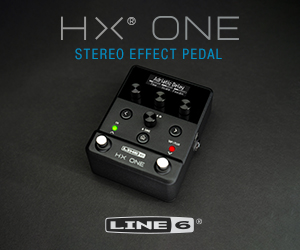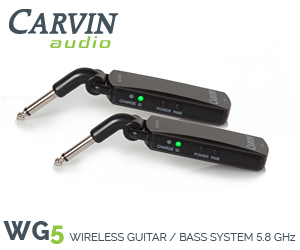Invite a Super Model To Your Studio – TASCAM’s Model Series Workstations Don’t Care Where Your Muse Takes You, It’s Ready To Bring Your Creativity To Life
trushack | Jun 27, 2021 | Comments 0
One thing that made the TASCAM Portastudio format popular was its intuitive form-factor. It looked exactly like most of us would imagine a “portable studio” would look like; a prominent mixing board-type of element seamlessly paired with a tape recorder. Working on a Portastudio definitely had the air of a real studio experience, even if it was just sitting at a desk in a bedroom.
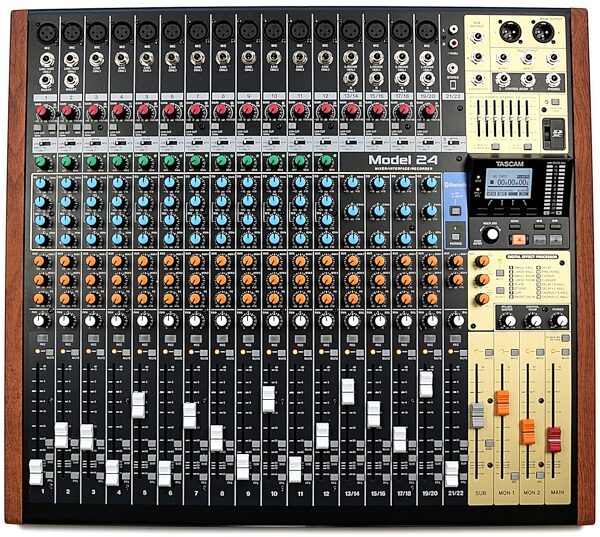
Tascam’s Flagship Model 24
The TASCAM Model 12, 16 and 24 are three versatile workstations that have brought this kind of design philosophy forward into a world that has gone crazy for in-the-box digital audio workstations (DAWs). The Model series essentially puts three powerful studio components all under one hood; a standalone recorder, interface and mixer. In an age where the phrase “home studio” can refer to recording, live-streaming, podcasting (the “radio” format many seem to have adopted) or video production work, any one of the TASCAM Model series units will get you going.
One of the coolest things one notices about the TASCAM Model series are the classic looks. You can easily imagine this sitting in a Bitcoin-per-hour, wood-paneled studio with a stuffed leather couch somewhere in New York City or Los Angeles or Nashville or any other hip creative destination. For whatever reason, this writer imagines the Who recording “Who By Numbers” when I look at a TASCAM Model unit. It just looks like a tool any one of your favorite classic albums might have been created with, and that’s inspiring in a way a standard DAW usually isn’t. It also adds a nice level of familiarity. If you’ve spent even a couple of minutes with a Portastudio or just about any mixer/standalone recorder, the Model series makes a lot of sense at first glance. Real faders and knobs and intuitive access to menus is important to everyone out there, no matter who experienced and sophisticated one might be around studio gear. In this case the TASCAM Model series sets you off on the right foot.
Ditch The DAW?
The Model Series definitely keeps the “Porta” spirit alive. All you need to start recording is, well, whichever TASCAM Model meets your needs, a basic set of headphones, maybe a mic, and an SD card (which is all stuff you should have anyway). All three models feature a range of reverbs, delays and modulation are available onboard, but you can also plug your favorite outboard units into the workflow. Want to throw a little compression on a track? Just tweak the green knob at the top of the channel strip and there it is. The EQ, with sweepable mids, is right where it always is on a mixer and there’s a Master EQ for global application. You’ve even got access to a click track, an overlooked feature that has a lot of utility. For instance, if you record a demo or rough track to the onboard click and like what you’ve done so much you want to drop the part into the final product, just keep that click going for your “real” tracks and the demo will slot right in with no tempo issues.
No DAW? No problem. As mentioned, the Model series is a true Portastudio heir in that it’s a self-contained recorder. Throw it in your Gremlin, hit the road to your favorite cabin in the woods and finally record that introspective folk-rock opera you’ve been tinkering with since you had detention in junior high. This writer may primarily use and, let’s be honest, enjoy a DAW now for all his recording needs, but recording the Portastudio way is a total blast. Now, I can do it that way again without ditching the DAW. Every trim line in the TASCAM Model series gives a ton of sound-shaping features to play with if you want to get crafty, but will also stay as pure and simple as you’d like.
Desire the DAW?
OK, maybe you’re reading this and saying, “Trushack, this all sounds great. But I love my DAW. I’ve got a ton of plug-ins I’ve invested in and all my work is saved there.” I got ya…and I have good news. Using a TASCAM Model series unit as your interface will take your DAW recording work to a whole other level. The Model series preamps also provide exceptional sound quality and low noise from the Model series preamps and the user is also able to control your DAW transport right from the TASCAM. You can do things such as move the playhead, connect the Model series physical faders to the virtual faders in your DAW, adjust panning, engage track muting and soloing, arm tracks for recording and a host of other actions.
As an interface, you’ll get a ton of flexibility from the input and output options, including a Bluetooth-capable input and the ability to connect. The Model series can also accommodate smartphones. This is great for capturing field and demos recordings made on a phone. All of those features blow past the capabilities of a typical interface in meaningful ways, but where things really get interesting is the capability for moving project files between your DAW and the Model series units.
Busting the Boundaries
Many musicians today are taking advantage of the unique community experiences provided by platforms like YouTube. While even the most bare-bones YouTube productions still attract massive online audiences, high production values have become key to making channels and presentations stand out. This is where the TASCAM Model series really has it all over other interface and production tools; it can easily and seamlessly switch gears to support the visual aspect of your creative endeavors. As the Tone King showed us in his live demo of the Model 24, all of the powerful features available in stand-alone and interface modes can be smoothly applied to either a live or pre-recorded YouTube production.
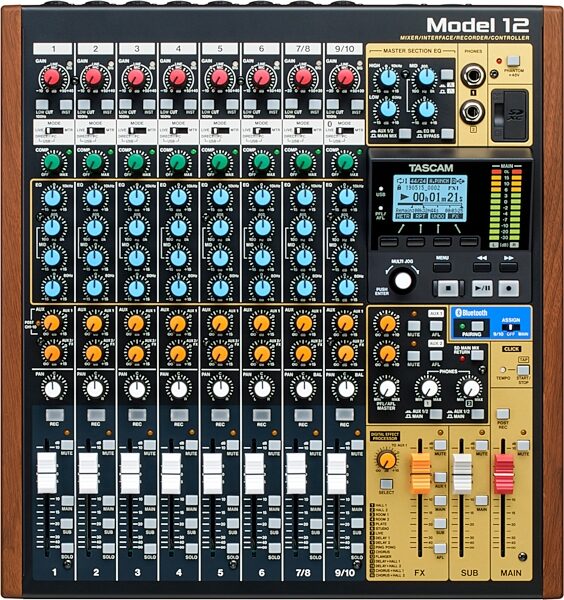
Tascam Model 12
Particular to the Model 12 is the availability of “mix minus” functionality. That means a person calling from a smart phone can be patched into the Model 12 during a podcast or livestream and hear the other signals except for the audio coming from the phone. Seems like a minor thing, but it prevents annoying feedback and other interference from spoiling the audio. For podcasters and YouTubers, this is a really useful piece of kit.
With the Model series, you’ve got that bevy of effects and channel strip features to add professional polish to your videos and podcasting. You can easily select and drop in pre-recorded tracks to your production and carefully craft a great-sounding mix for everything from a vocal/acoustic solo act to a full band for a livestream. It’s Portastudio footprint and functionality for a new generation of online community-building.
Which Model Should I Take Home?
Given the capabilities and the price-point of the TASCAM Model line, it’s really tough to go wrong with any of them. Between the Model 12, Model 16 and Model 24 you’ll find the expected differences in physical arrangement, channels, inputs, routing options, and channel strip parameters. The Model 12 provides 10 inputs for 12 total tracks, including eight XLR/quarter-inch inputs with associated preamps and phantom power. The Model 16 steps forward with 14 input channels feeding 16 tracks with dedicated XLR and quarter-inch options, again with phantom power available. Finally the Model 24 clocks in with 22 inputs and 24 tracks, with 16 XLR inputs, each supplied with phantom power.
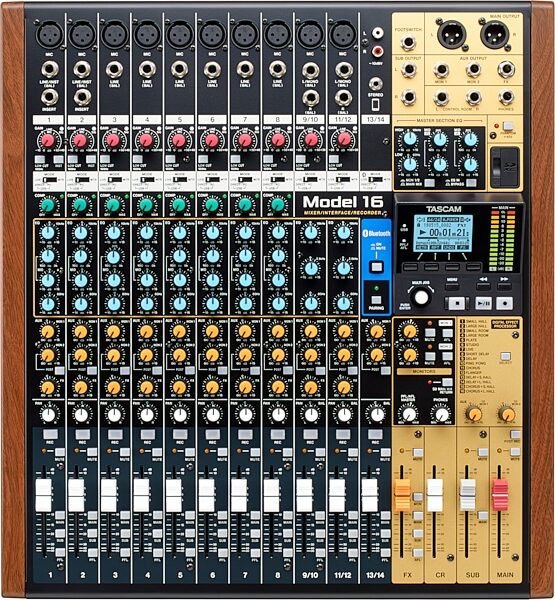
Tascam Model 16
The great news is that the essential capabilities of these units; self-contained recording, interface and DAW control and mixing, are unchanged between each of the three trim lines. Better still, even the most compact trim, the Model 12, offers capabilities above and beyond the typical interface or self-contained recording system. Any of the TASCAM Model series can serve as a highly-capable live recording platform, studio Swiss Army knife or podcast/YouTube production game-changer.
Tiny URL for this post:
Filed Under: Featured • Accessories
About the Author:


















